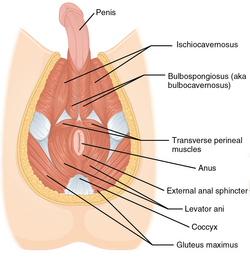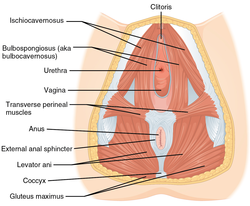Perineal hernia
| Perineum in humans | |
|---|---|
 The muscles of the male perineum | |
 The muscles of the female perineum | |
| Anatomical terminology |
Perineal hernia is a hernia involving the perineum (pelvic floor). The hernia may contain fluid, fat, any part of the intestine, the rectum, or the bladder. It is known to occur in humans, dogs, and other mammals, and often appears as a sudden swelling to one side (sometimes both sides) of the anus.
A common cause of perineal hernia is surgery involving the perineum.[medical citation needed] Perineal hernia can be caused also by excessive straining to defecate.[medical citation needed] Atrophy of the levator ani muscle and disease of the pudendal nerve may also contribute to a perineal hernia.[medical citation needed]
In humans
[edit]In humans, a major cause of perineal hernia is perineal surgery without adequate reconstruction. In some cases, particularly surgeries to remove the coccyx and distal sacrum, adequate reconstruction is very difficult to achieve. The posterior perineum is a preferred point of access for surgery in the pelvic cavity, particularly in the presacral space. Surgeries here include repair of rectal prolapse and anterior meningocele, radical perineal prostatectomy, removal of tumors including sacrococcygeal teratoma, and coccygectomy. Perineal hernia is a common complication of coccygectomy in adults,[1][2] but not in infants and children (see coccygectomy).
The standard surgical technique for repair of perineal hernia uses a prosthetic mesh,[3] but this technique has a high rate of failure due to insufficient anchoring. Promising techniques to reduce the rate of failure include an orthopedic anchoring system,[4] a gluteus maximus muscle flap,[1][5] an acellular human dermis graft,[5] and an acellular pig collagen graft.[6]
In dogs and cats
[edit]
In dogs, perineal hernia usually is found on the right side.[7] Most cases are in older intact (not neutered) male dogs (93 percent in one study).[8] Breeds that may be at risk include Welsh Corgis, Boxers, Australian Kelpies, Boston Terriers, Collies, Dachshunds, Old English Sheepdogs, and Pekingese.[9] Perineal hernias are rare in female dogs and uncommon in cats.
Dogs with benign prostatic hyperplasia have been found to have increased relaxin levels and suspected subsequent weakening of the pelvic diaphragm.[10] In cats, perineal hernias are seen most commonly following perineal urethrostomy surgery or secondary to megacolon.[11] Medical treatment consists of treatment of the underlying disease, enemas, and stool softeners. Because only about 20 percent of cases treated medically are free of symptoms, surgery is often necessary.[11] Recurrence is common with or without surgery.
Several surgeries have been described for perineal hernias in dogs. The current standard involves transposition of the internal obturator muscle. This technique has a lower recurrence and complication rate than traditional hernia repair. A new technique uses porcine small intestinal submucosa as a biomaterial to help repair the defect. This is can also be done in combination with internal obturator muscle transposition, especially when that muscle is weak.[12]
References
[edit]- ^ a b Zook NL, Zook EG (1997). "Repair of a long-standing coccygeal hernia and open wound". Plast. Reconstr. Surg. 100 (1): 96–9. doi:10.1097/00006534-199707000-00017. PMID 9207665.
- ^ García FJ, Franco JD, Márquez R, Martínez JA, Medina J (1998). "Posterior hernia of the rectum after coccygectomy". Eur J Surg. 164 (10): 793–4. doi:10.1080/110241598750005462. PMID 9840311.
- ^ Kumar A, Reynolds JR (2000). "Mesh repair of a coccygeal hernia via an abdominal approach". Annals of the Royal College of Surgeons of England. 82 (2): 113–5. PMC 2503516. PMID 10743431.
- ^ Berrevoet F, Pattyn P (2005). "Use of bone anchors in perineal hernia repair: a practical note". Langenbecks Arch Surg. 390 (3): 255–8. doi:10.1007/s00423-004-0523-6. PMID 15580523. S2CID 10049165.
- ^ a b Brizendine JB, LeFaivre JF, Yost MJ, Fann SA (2006). "Reconstruction of parasacral hernia with acellular human dermis graft". Hernia. 10 (4): 360–3. doi:10.1007/s10029-006-0092-4. PMID 16705361. S2CID 33604955.
- ^ Abhinav K, Shaaban M, Raymond T, Oke T, Gullan R, Montgomery AC (April 2008). "Primary reconstruction of pelvic floor defects following sacrectomy using Permacoltrade mark graft". Eur J Surg Oncol. 35 (4): 439–43. doi:10.1016/j.ejso.2008.03.007. PMID 18439796.
- ^ Head L, Francis D (2002). "Mineralized paraprostatic cyst as a potential contributing factor in the development of perineal hernias in a dog". J Am Vet Med Assoc. 221 (4): 533–5, 500. doi:10.2460/javma.2002.221.533. PMID 12184704.
- ^ Seim, Howard B., III (2004). "Perineal Hernia Repair". Proceedings of the 29th World Congress of the World Small Animal Veterinary Association. Retrieved 2007-03-25.
{{cite web}}: CS1 maint: multiple names: authors list (link) - ^ "Perineal Hernia". The Merck Veterinary Manual. 2006. Retrieved 2007-03-25.
- ^ Niebauer G, Shibly S, Seltenhammer M, Pirker A, Brandt S (2005). "Relaxin of prostatic origin might be linked to perineal hernia formation in dogs". Annals of the New York Academy of Sciences. 1041 (1): 415–22. Bibcode:2005NYASA1041..415N. doi:10.1196/annals.1282.062. PMID 15956739. S2CID 5754439.
- ^ a b Hoskins, Johnny D. (September 2006). "Anorectal Disease". DVM. Advanstar Communications: 8S–10S.
- ^ Ettinger, Stephen J.; Feldman, Edward C. (2005). Textbook of Veterinary Internal Medicine (6th ed.). W.B. Saunders Company. ISBN 1-4160-0110-7.
